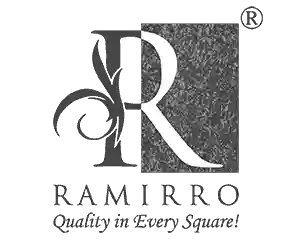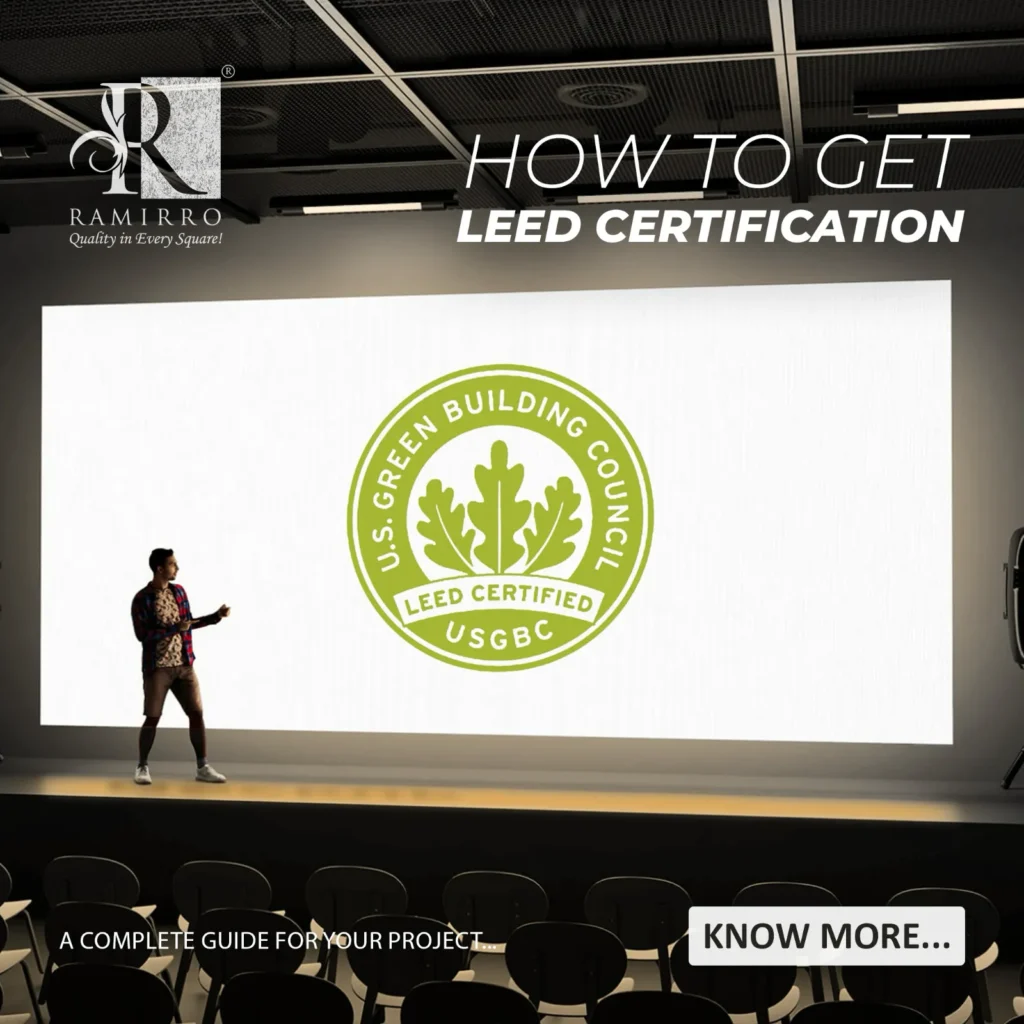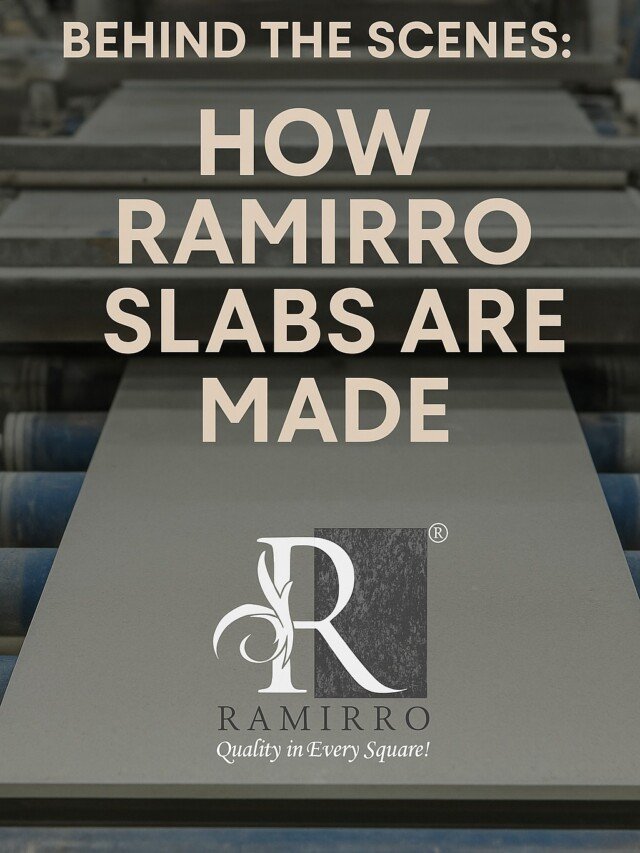Achieving LEED certification is a powerful way to showcase your commitment to sustainability and environmental responsibility. Whether you’re planning a residential, commercial, or industrial project, LEED (Leadership in Energy and Environmental Design) provides a globally recognized green building certification system. It helps you create energy-efficient, eco-friendly spaces while adding long-term value to your property. This guide will walk you through the step-by-step process of obtaining LEED certification, understanding its levels, and leveraging the expertise of LEED-accredited professionals. Start your journey toward building a greener future today!
- Understanding LEED Certification:
- Benefits of LEED Certification
- Steps to Get LEED Certification
- Common Challenges in Achieving LEED Certification
- Tips for a Successful LEED Certification
- Real-World Examples of LEED-Certified Projects
- Why LEED Certification Matters Today
- Shop Eco-Friendly Tiles for Your Green Building Projects at Ramirro Ceramica
- Related Articles
Understanding LEED Certification:
What is LEED?
LEED, or Leadership in Energy and Environmental Design, is the world’s most widely used green building rating system. It was developed by the U.S. Green Building Council (USGBC) to promote sustainable design and construction practices. LEED provides a framework for designing, constructing, operating, and maintaining buildings that are environmentally responsible and resource-efficient.
Projects eligible for LEED certification include:
- Residential buildings: Single-family homes, apartments, and condominiums.
- Commercial buildings: Office spaces, retail stores, and warehouses.
- Industrial facilities: Factories and manufacturing plants.
- Public projects: Schools, hospitals, and government buildings.
LEED certification applies to both new construction and existing buildings, making it versatile for any project type.
Levels of LEED Certification
LEED certification is awarded based on the number of points a project earns by meeting sustainability criteria. There are four certification levels:
- Certified: 40–49 points.
- Silver: 50–59 points.
- Gold: 60–79 points.
- Platinum: 80+ points.
These points are earned by implementing strategies that enhance energy efficiency, water conservation, material selection, indoor environmental quality, and more. The higher the points, the more sustainable the project, with Platinum being the highest standard of achievement.
LEED Rating Systems
Building Design and Construction (BD+C):
Focuses on the design and construction of new buildings or major renovations. Applicable to schools, healthcare facilities, and warehouses.
Interior Design and Construction (ID+C):
Targets interior spaces of buildings, such as office renovations or retail fit-outs.
Operations and Maintenance (O+M):
Designed for existing buildings seeking to improve their operational efficiency and sustainability.
Neighborhood Development (ND):
Addresses sustainable community planning and infrastructure development.
Homes:
Tailored to single-family and multifamily residential projects.
Cities and Communities:
Focuses on broader urban sustainability by certifying entire cities or communities.
Benefits of LEED Certification
Environmental Benefits
LEED-certified buildings significantly reduce their carbon footprint by promoting energy efficiency and water conservation. These structures typically consume 25% less energy and emit 34% less CO2 compared to conventional buildings. By utilizing sustainable building materials and innovative design techniques, LEED projects also contribute to improved air quality and reduced pollution levels in their surroundings. LEED encourages the use of renewable energy sources and efficient HVAC (heating, ventilation, and air conditioning) systems, which collectively enhance the overall environmental performance of buildings.
Economic Advantages
From an economic perspective, LEED certification can lead to lower operational costs due to reduced energy and water consumption. Studies indicate that LEED-certified buildings can save between 30% to 60% on energy costs compared to non-certified structures. These buildings often experience increased property values; homes with green certifications have been shown to sell for an average of 9% more than comparable non-certified homes. This financial incentive makes LEED certification an attractive option for developers and investors alike.
Enhanced Reputation and Marketability
LEED certification enhances a project’s reputation by signaling a commitment to sustainability. This recognition can improve marketability, attracting environmentally conscious tenants and buyers. Businesses operating in LEED-certified spaces often enjoy higher occupancy rates and tenant satisfaction due to the health benefits associated with improved indoor environmental quality.
Alignment with Global Sustainability Goals
LEED certification aligns with broader global sustainability initiatives, helping organizations meet their Environmental, Social, and Governance (ESG) objectives. By achieving LEED standards, companies contribute to international efforts aimed at combating climate change and promoting sustainable development.
Incentives and Tax Benefits
In many regions, governments offer incentives for pursuing LEED certification, including tax benefits, grants, and expedited permitting processes. These financial incentives can further offset the initial costs associated with sustainable building practices, making it economically viable for more projects to pursue LEED certification.
Steps to Get LEED Certification
Step 1: Evaluate Your Project Eligibility
Determine if your project aligns with LEED’s green building certification criteria.
Identify the appropriate LEED rating system based on your project type:
- Building Design and Construction (BD+C) for new builds or major renovations.
- Interior Design and Construction (ID+C) for fit-outs and interior upgrades.
- Operations and Maintenance (O+M) for existing buildings improving efficiency.
- Neighborhood Development (ND) for community planning projects.
- Homes for residential properties.
- Cities and Communities for urban-scale projects.
Step 2: Register Your Project
Visit the U.S. Green Building Council (USGBC) website to register your project. Pay the required registration fee, which varies depending on project type and size. Gather essential documentation, including project details, location, and intended sustainability goals.
Step 3: Understand the LEED Credit System
LEED operates on a point-based system. To earn certification, your project must meet prerequisites and achieve points in key categories:
- Sustainable Sites: Minimize environmental impact through responsible site development.
- Water Efficiency: Incorporate water-saving fixtures and landscaping practices.
- Energy and Atmosphere: Optimize energy performance with efficient systems and renewable energy sources.
- Materials and Resources: Use sustainable, recycled, or low-impact materials.
- Indoor Environmental Quality: Enhance occupant comfort through better air quality and natural lighting.
Strategies to Maximize Points:
Consult with LEED-accredited professionals such as LEED APs or LEED Green Associates for insights into maximizing points in each category.
Step 4: Develop a Sustainability Plan
Engage a team of experts, including LEED-accredited professionals, architects, and engineers. Conduct energy modeling and environmental assessments to identify areas for improvement. Integrate energy-efficient technologies, sustainable materials, and innovative design practices into your project. Ensure alignment with LEED v5 requirements to meet updated standards.
Step 5: Documentation and Application
Collect all required documentation, such as drawings, calculations, and reports. Submit your application to the Green Business Certification Inc. (GBCI) through the LEED Online portal. Ensure your documentation clearly demonstrates compliance with prerequisites and earned credits.
Step 6: LEED Review Process
The GBCI will review your application in two stages:
Preliminary Review: Receive feedback and identify any areas needing clarification.
Final Review: Submit additional documentation or responses, if required.
Stay proactive and address any questions or requests from the GBCI promptly.
Step 7: Certification Award
Once approved, you’ll receive your LEED certification, specifying the certification level achieved (Certified, Silver, Gold, or Platinum). Celebrate your achievement and promote your project as a model of sustainable development. Plan for ongoing monitoring and improvements to maintain or enhance your certification over time.
Common Challenges in Achieving LEED Certification
Cost Considerations and Budgeting
Initial Investment: Implementing energy-efficient systems, sustainable materials, and design strategies can be costly upfront.
Certification Fees: Registration and certification fees vary by project type and size, adding to the budget.
Long-Term Savings vs. Short-Term Costs: Balancing the long-term operational savings of a LEED-certified building with the immediate costs can be challenging, particularly for smaller projects.
Solution: Conduct a cost-benefit analysis early in the process to plan for expenses and highlight the financial advantages over time.
Navigating Complex Documentation and Submission Requirements
Extensive Documentation: LEED certification requires detailed documentation for every credit pursued, which can be time-consuming.
Precision Required: Errors in submissions can lead to delays or the rejection of certain credits.
LEED v5 Updates: Staying up-to-date with the latest changes in the LEED rating system adds complexity.
Solution: Engage experienced LEED-accredited professionals, such as LEED Green Associates or LEED APs, to streamline documentation and ensure compliance.
Balancing Sustainability Goals with Project Constraints
Design Limitations: Achieving sustainability goals while adhering to functional and aesthetic requirements can be a challenge.
Time Pressure: Tight project timelines may limit the ability to fully explore and implement sustainable practices.
Stakeholder Alignment: Gaining consensus among stakeholders with differing priorities can delay decision-making.
Solution: Develop a clear sustainability plan early in the project and communicate the value of LEED certification to all stakeholders.
Overcoming Technical Challenges in Older or Existing Buildings
Energy Efficiency Retrofits: Older buildings may require extensive upgrades to meet LEED prerequisites, such as improving insulation, HVAC systems, and lighting.
Space Limitations: Limited space may restrict the integration of certain sustainable technologies, like green roofs or solar panels.
Operational Disruptions: For existing buildings, achieving LEED certification might require temporary interruptions in daily operations.
Solution: Focus on the LEED Operations and Maintenance (O+M) rating system, which is tailored for existing buildings, and work with specialists to identify feasible upgrades.
Tips for a Successful LEED Certification
Start Planning Early in the Design Phase: Initiating your sustainability efforts during the design phase is crucial. Early planning allows you to integrate sustainable practices seamlessly into your project, making it easier to meet LEED requirements. This proactive approach can help identify potential challenges and opportunities for earning credits before construction begins.
Partner with LEED-Accredited Professionals and Consultants: Collaborating with professionals who have expertise in LEED certification can significantly streamline the process. Engage LEED-accredited professionals, such as architects, engineers, and sustainability consultants, who understand the intricacies of the certification process. Their guidance can help you navigate the requirements effectively and identify strategies to maximize your points.
Invest in Energy Modeling and Simulation Tools: Utilizing energy modeling and simulation tools can provide valuable insights into your building’s performance. These tools allow you to analyze energy consumption, optimize design features, and explore various scenarios to achieve energy efficiency goals. By investing in these technologies early on, you can make informed decisions that align with LEED standards.
Keep Detailed Records of Every Phase of the Project: Maintaining thorough documentation throughout the project is essential for demonstrating compliance with LEED requirements. Keep detailed records of materials used, design changes, and sustainability measures implemented at each stage. This organized approach will facilitate the documentation process when submitting your application for certification.
Real-World Examples of LEED-Certified Projects
One Bryant Park, New York City, NY
Certification Level: LEED Platinum
Highlights: This skyscraper incorporates a 4.6-megawatt cogeneration plant and utilizes collected rainwater and recycled greywater for its operations. The building’s design significantly reduces CO2 emissions and operational costs.
Willis Tower, Chicago, IL
Certification Level: LEED Platinum (2019)
Highlights: Following extensive renovations, including an upgraded HVAC system and energy-efficient lighting, Willis Tower became the largest building in the U.S. to achieve top-level accreditation under the latest LEED v4.1 rating system.
Frick Environmental Center, Pittsburgh, PA
Certification Level: LEED Platinum
Highlights: As the world’s first Living Building Challenge project open to the public, this center emphasizes environmental education and features sustainable design elements that promote energy efficiency and resource conservation.
Yale School of the Environment, New Haven, CT
Certification Level: LEED Platinum
Highlights: Kroon Hall, part of this campus, uses 58% less energy than similar buildings and incorporates sustainable practices such as a gray water system and a solar panel array.
Vancouver Convention Centre, Vancouver, Canada
Certification Level: LEED Platinum
Highlights: This facility features a six-acre living roof and a seawater heating and cooling system, showcasing innovative approaches to sustainability in large-scale projects.
Apple Park, Cupertino, CA
Certification Level: LEED Platinum
Highlights: Apple’s headquarters exemplifies sustainable design with its circular layout and extensive use of natural ventilation and renewable energy sources.
Lessons Learned and Best Practices
Integrate Sustainability Early: Projects like One Bryant Park demonstrate the importance of incorporating sustainability practices from the design phase. Early integration allows for more effective planning and implementation of energy-efficient systems.
Embrace Renovation Opportunities: The success of older buildings like Willis Tower shows that retrofitting existing structures can yield significant sustainability benefits while preserving historical value.
Focus on Education and Community Engagement: The Frick Environmental Center highlights the value of designing spaces that not only serve functional purposes but also educate the public about sustainability.
Utilize Innovative Technologies: Buildings like the Vancouver Convention Centre illustrate how adopting cutting-edge technologies—such as seawater systems for heating and cooling—can enhance sustainability outcomes.
Commit to Continuous Improvement: Projects such as Apple Park emphasize that achieving high levels of sustainability is an ongoing process that involves regular assessments and updates to maintain certification status.
Why LEED Certification Matters Today
Connection to Climate Change: Buildings are major contributors to greenhouse gas emissions, accounting for nearly 40% globally. LEED-certified buildings reduce their carbon footprint, producing 34% fewer CO2 emissions compared to traditional structures. This makes LEED a vital tool in combating climate change.
Increased Demand for Sustainable Practices: There is a growing preference for sustainable construction among investors, tenants, and consumers. LEED certification enhances a building’s marketability and value, reflecting the broader societal shift toward environmental stewardship.
Contribution to Long-Term Sustainability Goals: LEED provides a comprehensive framework that promotes energy efficiency, water conservation, and the use of sustainable materials. Initiatives like LEED Zero, which recognizes net-zero energy buildings, highlight its adaptability to evolving sustainability challenges.
Shop Eco-Friendly Tiles for Your Green Building Projects at Ramirro Ceramica
Shop Now | Chat With Expert | View Catalogue
At Ramirro Ceramica, we offer a wide range of eco-friendly tiles that are perfect for your projects. You can conveniently shop our collection both online and offline, where our team will assist you in selecting the best tiles that align with eco friendly practices. Our collection includes a variety of sustainable and stylish options designed to meet the needs of eco friendly building projects, ensuring that your space is both environmentally responsible and aesthetically appealing. For more details or inquiries, feel free to contact us, and we’ll guide you through the selection process to meet your sustainability goals.
Related Articles
LEED Certified Green Building: Eco Friendly Materials & Tile Ideas
Eco Tile: Sustainable Floor Tiles and Eco friendly Options
Ramirro: Porcelain Tiles and Ceramic Tiles Manufacturer
Eco-Friendly Tile & Sustainable Tile Flooring Solutions
Top 11 Safety Measures for Floor Tile Selection to Avoid Mistakes
Choosing the Right Tiles for Wellness Interior Design
3+ Innovative Recycled Plastic Tile Products & Alternatives






